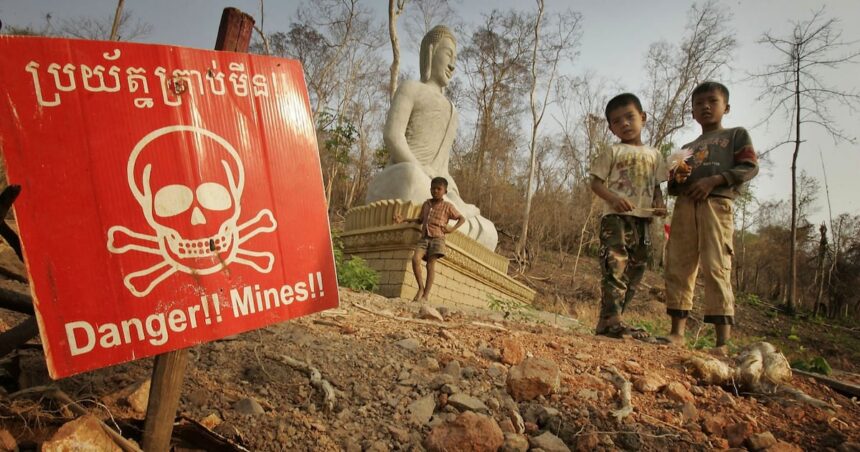Article – I landed in Ottawa last week as snow dusted Parliament Hill, a fitting backdrop for what many diplomats are calling a “cold front” in international humanitarian law. Twenty-seven years after Canada spearheaded the Ottawa Treaty banning anti-personnel landmines, the landmark agreement faces its greatest challenge yet as six nations announce their withdrawal from the pact.
“We’re witnessing the unraveling of what many considered settled international consensus,” says Margot Wallström, former Swedish Foreign Minister, speaking to me in a quiet corner of the Fairmont Château Laurier. “The timing couldn’t be more symbolic – just as the world prepares to mark the treaty’s 30th anniversary in 2027.”
The departing nations – Poland, Bulgaria, Romania, Peru, Jordan, and most surprisingly, Finland – cite “evolving security challenges” and “border integrity concerns” in their formal notifications. But beneath the diplomatic language lies a troubling shift in how nations perceive the balance between humanitarian obligations and military utility.
In the basement archive room of the Canadian War Museum, I pore over documents from the original 1997 negotiations. The papers bear witness to what was once hailed as “the Ottawa Process” – a revolutionary fast-track diplomatic initiative that circumvented traditional arms control channels. Canada’s then-Foreign Minister Lloyd Axworthy pushed the treaty through in just 14 months, earning a Nobel Peace Prize nomination for his efforts.
“We were determined to end the indiscriminate killing,” recalls Robert Lawson, one of the original Canadian negotiators, now retired. “Each month, landmines were killing or maiming 2,000 civilians worldwide – one person every twenty minutes. Mostly children and farmers.”
The treaty’s success has been undeniable. According to the International Campaign to Ban Landmines, global production has nearly ceased, trade has virtually stopped, and over 55 million stockpiled mines have been destroyed. Annual casualties dropped from approximately 20,000 in the late 1990s to around 5,500 in 2022.
Yet the recent withdrawals threaten to reverse this progress. Poland’s Prime Minister Szymon Hołownia justified his country’s decision by pointing to “Russia’s aggressive posture” along NATO’s eastern flank. “We cannot afford humanitarian idealism at the expense of national security,” he stated during a press conference in Warsaw that I attended virtually last Tuesday.
The Ottawa Treaty contains a six-month notice period for withdrawal – meaning these six nations will officially exit by January 2026. But the diplomatic fallout is already reverberating through international channels.
“This is potentially catastrophic for civilian protection,” says Jody Williams, who received the 1997 Nobel Peace Prize for her work with the International Campaign to Ban Landmines. Speaking via video call from her Vermont home, Williams doesn’t mince words: “Let’s be clear about what’s happening – countries are reclaiming the right to use weapons that, by design, cannot distinguish between a soldier and a child.”
At Canada’s Department of Global Affairs, the mood is somber but resolute. “We’re engaging directly with each withdrawing state,” Foreign Minister Mélanie Joly tells me. “Canada’s position remains unwavering – these weapons cause disproportionate humanitarian harm long after conflicts end.”
The treaty’s current 159 state parties include most NATO members, though notable exceptions remain. The United States, Russia, China, India, and Pakistan never joined. American reluctance has always centered on the Korean Peninsula, where Washington maintains that landmines are necessary to deter North Korean aggression.
Financial implications of the withdrawals are significant. The Landmine Monitor reports that international funding for mine clearance reached $737.2 million in 2023. Any reduction could leave contaminated communities at greater risk. Cambodia, Angola, and Bosnia-Herzegovina still struggle with deadly fields decades after their conflicts ended.
In Phnom Penh last year, I met Chhay Sopheak, who lost his right leg to a landmine while farming in 2001. “The foreigners who planted these bombs are gone,” he told me, “but we still pay the price every day.” Cambodia reports that landmines and unexploded ordnance have killed or injured over 65,000 people since 1979.
The treaty withdrawals come amid broader challenges to the international humanitarian order. The World Food Programme faces funding shortfalls exceeding $900 million. The International Criminal Court confronts increasing non-cooperation. And the Convention on Cluster Munitions, which followed the Ottawa Treaty’s template, has seen decreased compliance during recent conflicts.
“We’re seeing erosion across multiple fronts,” explains Dr. Helen Durham, former Director of International Law at the International Committee of the Red Cross. “The landmine treaty withdrawals are part of a dangerous pattern where humanitarian principles are being subordinated to security interests.”
For veterans of the original Ottawa Process, these developments represent a painful setback. Ambassador Wolfgang Petritsch, who helped negotiate the treaty, expressed particular disappointment with European withdrawals. “These were nations that championed humanitarian disarmament. Their retreat sends a terrible signal about the durability of such commitments.”
The withdrawal decisions aren’t without domestic opposition. In Helsinki, thousands gathered in Senate Square last Sunday, many carrying shoes symbolizing limbs lost to landmines. Inside Finland’s Parliament House, legislators remain deeply divided, with several threatening to resign in protest.
Not all is bleak. Chile announced the completion of its mine clearance operations last month, joining 33 other countries that have fulfilled their treaty obligations. Colombia continues making progress despite its challenging terrain. And Mozambique, once among the world’s most heavily mined countries, declared itself mine-free in 2015.
As snow continues falling outside my hotel window, I’m reminded of what a Cambodian deminer told me: “Each mine we remove is a life potentially saved.” The Ottawa Treaty’s future may be uncertain, but its past accomplishments – thousands of lives preserved, vast territories reclaimed – remain undeniable.
The question now is whether Canada can reignite the humanitarian spirit that drove the original process. As one diplomat put it to me, speaking on condition of anonymity: “The treaty was born in Ottawa. If it’s to be saved, that rescue might need to begin here too.”






